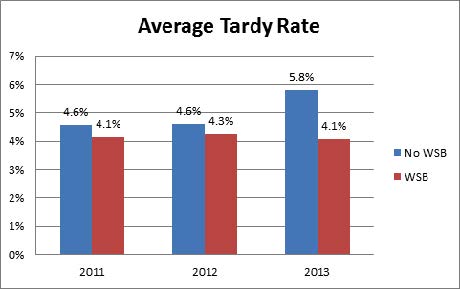
Share On Social!
An elementary school is proving that morning exercise through a walking school bus program can benefit students, parents, and the community.
Not only have school attendance rates increased, community engagement levels have increased, too. A Walking School Bus at Brightwood Elementary School in Springfield, Mass., now offers hope—and physical activity—to a community that not long ago faced fears of unsafe streets and high crime rates.
Karen Pohlman, a nurse practitioner and community program manager for Baystate Medical Center, knew the community was struggling and wanted to improve people’s health, so she developed a plan to implement a walking school bus at Brightwood Elementary.
The Need for Physical Activity among Children
Awareness: Crime was high in the North End of Springfield, Mass., which includes the three neighborhoods of Brightwood, Memorial Square, and Liberty Heights.
Many parents did not feel that it was safe for their children to play outside, said Nurse Practitioner Karen Pohlman, who has worked in the North End for several years. Pohlman has seen some of the problems that plagued the community—namely, that crime was preventing kids from attending school and seeking outdoor physical activity.
Law enforcement officials in the North End sought new ways to deter criminal activity and gang violence, so they developed a Counter Criminal Continuum (C3) initiative. A C3 initiative is a collaborative effort between the city, police, and community members, in which everyone plays a role in keeping the neighborhood safe.
As part of the C3 initiative, community members meet regularly to alert law enforcement officials of suspicious activities. They also meet to discuss community safety improvements.
Learn: Wanting to make a difference in Brightwood, Pohlman decided to attend a C3 community meeting.
“I was thinking about all the barriers to wellness that face my patient population, and safety obviously was one of the biggest constraints,” Pohlman said, also citing obesity issues.
Pohlman said meeting attendees displayed a strong desire for community improvement.
“It was a different variety of folks and I think that was the catalyst to start thinking of something that, not only would fit the bill with me as a health initiative, but also fit the bill with these people that I didn’t historically go to meetings with—state troopers and police,” Pohlman said.
The group, knowing of Pohlman’s background in community health, charged her with coming up with a way to impact local health and safety.
Pohlman now had to come up with a plan to help the community. Pohlman, who runs a free clinic in Brightwood Elementary, had already established a relationship with the school principal. So she asked the principal, Shalimar Colon, to explain the school’s top issues. Pohlman learned absenteeism and academic performance were the biggest concerns at Brightwood. Because of this, the school was facing closure by the federal government. Overall, a high percentage of students were chronically absent from Springfield Public Schools.
Frame Issue: Students attending Brightwood were predominantly Latino (86.1%). The school needed a way to address absenteeism, low parent involvement, and childhood obesity.
While pondering this, she remembered once reading something about a walking school bus—where kids and parents joined together to walk to school in large groups. She wasn’t sure a walking school bus could work in a school with less active parent-teacher organizations.
After looking for more information online, Pohlman realized that a walking school bus might offer a solution to Brightwood’s problems. It was a “multi-spoked program that spoke to a lot of the issues and I could sell it at any meeting.” Pohlman said.

She had six objectives for a walking school bus program:
- Daily exercise to aid in reducing childhood obesity.
- Increased safety for the children and neighborhood.
- Decreased school absenteeism/ tardiness.
- Increased learning capacity.
- Reduction of the carbon footprint.
- More community engagement.
Despite the district’s existing wellness policy, few had taken notice of the policy.
A 2006 version of the Springfield Public School District’s wellness policy encouraged schools to seek opportunities for walking to school when available. One of the policy’s goals was to “provide more opportunities for students to engage in physical activity.” The policy also stated that “schools should encourage parents and community members to institute programs that support physical activity, such as a ‘walk to school’ program.”
Developing a Plan to Increase Physical Activity among Children
Education: Pohlman proposed the walking school bus idea to the school principal.
She explained to the principal how the walking school bus could help tackle high absenteeism, tardy arrivals, and the lack of parent engagement—while also promoting physical activity.
Mobilization: Principal Colon invited Pohlman to join a school leadership team. As part of this team, Pohlman was able to write the walking school bus program into the school’s turnaround plan, as a tool for attendance.
If approved by the district, the plan would provide Brightwood with funds to pay teachers a small stipend for supervising children as part of the walking school bus program. A map was used to establish walking routes no farther than 1.5 miles from the school.
Debate: Teachers supported the walking school bus because those who decided to participate would receive payment for walking with the children. The possibility of increased attendance was also a key point that convinced teachers to be a part of the walking school bus.
Parents, on the other hand, were at first weary about letting their children participate, expressing concerns mainly over “stranger danger” and traffic safety.
To help put parents at ease, the principal agreed to walk with the children when program first started.
Enacting a Plan to Increase Physical Activity among Children

(Source: Karen Pohlman)
Activation: English and Spanish flyers were created for the new walk to school program.
Information about the walking school bus, meeting points, and teachers was sent home.
The walking school bus program started to generate strong support from neighborhood partners. Through the C3 initiative, Pohlman was able to invite law enforcement agents like Michael Cutone to participate in a walk-to-school day with Brightwood students.
“We want the kids to know that we want to make a difference in their lives. We want to be there to help,” Cutone said in an ABC 40 news report.
Frame: The team decided that they would launch the program starting with just one route to school.
A program facilitator and two teachers were chosen to start up the walking school bus.
Change: Once the school’s turnaround plan was approved, the first walking school bus at Brightwood elementary started during Fall 2010 with about 6-10 students. Children were led to school every day of the week by two teachers who received stipends to do so.
After seeing the success of Brightwood’s walking school bus and learning about the increased need for physical activity, district board members were willing to update the district’s wellness policy.
Pohlman, who also is part of the Springfield Public School District’s Health Advisory Board, collaborated on the updates to the district’s wellness policy.
On October 11, 2012 a revised wellness policy was made effective that includes this provision: “each school will be strongly encouraged to take part in additional activities to promote student health, such as joining safe routes to school or developing a walking school bus.”
Sustaining a Plan to Increase Physical Activity among Children
Implementation: “I think the whole neighborhood watched those kids walking Monday through Friday to school,” said Pohlman.

Gradually more parents decided to allow their children to be a part of the walking school bus and by the end of the first year there were 40-50 students walking to school every morning.
As anticipated, levels of school attendance increased and tardiness decreased. Parent-teacher interaction also increased.
According to a Springfield Public School District’s newsletter, the walking school bus has also brought benefits to the teachers. “The walk leaves me invigorated for the day,” said Claire Labonte, an instructional leadership specialist at Brightwood.
During the second year, participation rose to 134 students. Parents were asking for more walking school buses.
Preliminary results have shown that walking school bus participants have a 2-percent higher rate of attendance than their peers.

In 2011, Pohlman was approached by Nicole Bourdon, Program Director for Mass in Motion—a statewide initiative that seeks to improve healthy eating and increase physical activity in Massachusetts. Mass in Motion offered Pohlman ongoing support to expand the number of routes at Brightwood Elementary to three.
Through Mass in Motion, Pohlman learned about Safe Routes to School (SRTS) the Safe Routes to School Partnership, and the Massachusetts SRTS State Chapter.
“As soon as I found them [Safe Routes to School], I signed on and they became great resources,” Pohlman said.
Safe Routes to School offers valuable resources to help parents, educators, and community leaders—like herself—organize walking school bus and bike to school programs.
“I’ve been able to gather a lot of community support,” Pohlman said.
Through newly formed partnerships, Pohlman has had the opportunity to present her school’s walking school bus program to other schools. As a result, at least three other schools are considering developing a walking school bus program of their own.
“Mass in Motion was involved in getting more city-wide support for Karen’s walking school bus and in the creation of the task force,” said Bourdon.
Now community leaders have joined efforts to form the Springfield Safe Routes to School Alliance. Through this alliance, leaders in Springfield hope to see more kids walking and biking to school.
Sustainability: Although funds to pay teachers may eventually run out, Pohlman believes teachers will continue the tradition of having a walking school bus at Brightwood. “The teachers who have been doing it all along will probably volunteer their time,” said Pohlman. Other ways to reduce the costs of the walking school bus are also being discussed.
“It’s really a low-cost sustainable program, which so many people can buy into.” Pohlman said.
In the future, program leaders hope to include an afternoon walk home and that parents will eventually take over the program.
More recently, Pohlman had the opportunity to partner with the Massachusetts Department of Transitional Assistance (DTA), and now parents of Brightwood students who need to fulfill community service hours for the DTA can do so by volunteering as chaperones for the Walking School Bus.
By The Numbers
27
percent
of Latinos rely on public transit (compared to 14% of whites).
This success story was produced by Salud America! with support from the Robert Wood Johnson Foundation.
The stories are intended for educational and informative purposes. References to specific policymakers, individuals, schools, policies, or companies have been included solely to advance these purposes and do not constitute an endorsement, sponsorship, or recommendation. Stories are based on and told by real community members and are the opinions and views of the individuals whose stories are told. Organization and activities described were not supported by Salud America! or the Robert Wood Johnson Foundation and do not necessarily represent the views of Salud America! or the Robert Wood Johnson Foundation.



